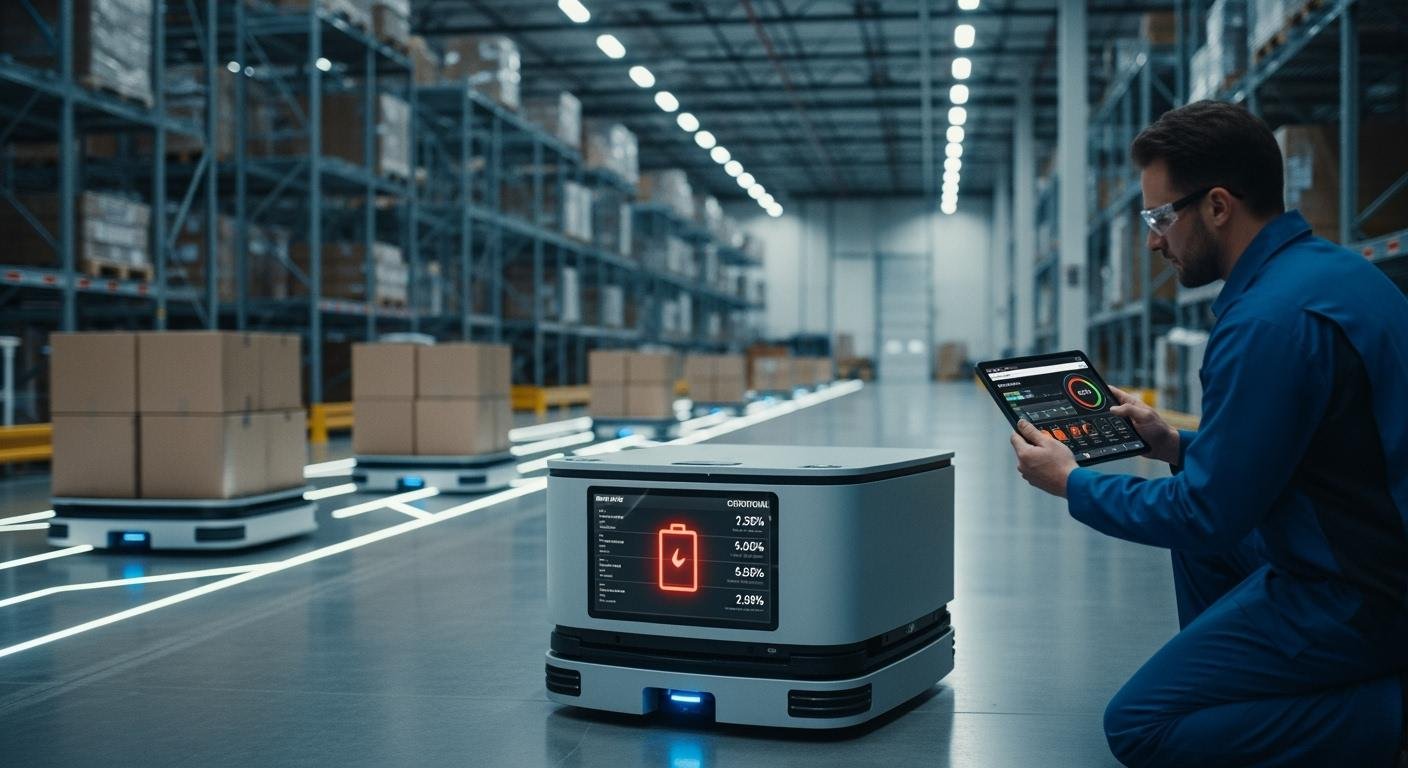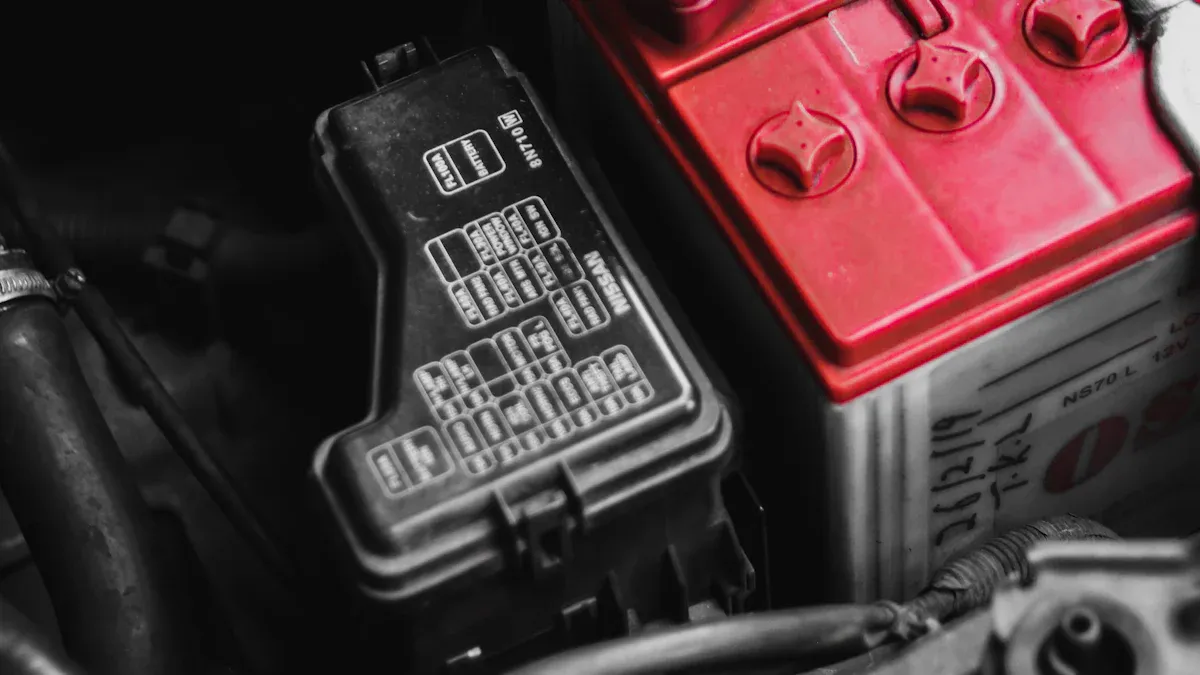
Your automated guided vehicles grind to a halt. You face another costly AGV robots battery failure. This shutdown often happens because of a few common problems. Understanding these causes is the first step to protecting your investment. The main reasons your AGV battery fails prematurely include:
- Improper charging routines that strain the battery.
- Heavy operational demands placed on your fleet.
- Poor environmental conditions during operation or storage.
Key Causes of AGV Robots Battery Failure

You must understand the root causes of battery issues to prevent them. A detailed failure analysis often points to a few common culprits in your daily operations. This analysis helps you pinpoint weaknesses in your processes. Let’s explore the main reasons for premature agv robots battery failure.
Improper Charging
Improper charging is a primary cause of battery degradation. This happens when you use incorrect charging methods or schedules for your battery chemistry. For example, you might use a charger not designed for your specific battery type or interrupt charging cycles incorrectly.
Remarque : Different battery types respond differently to charging methods. Lead-acid batteries need a full charge cycle. Frequent, short charging sessions damage them. In contrast, lithium-ion batteries thrive with opportunity charging. You can charge them during short breaks without harming the battery. Warehouses using this method for their AGV and AMR fleets report up to a 35% increase in vehicle utilization.
Proper charging protocols use smart technology to protect your investment. These systems communicate directly with the battery management system (BMS).
| Fonctionnalité | Description |
|---|---|
| Communication Protocols | Uses CAN bus or Modbus for real-time data exchange. |
| Smart Control | Adapts current and voltage based on the battery’s status. |
| Safety Protections | Includes safeguards for over-voltage and short-circuits. |
| BMS Integration | Shares vital data on temperature and state of charge (SoC). |
Deep Discharging
You practice deep discharging when you run a battery down to empty or near-empty before recharging. While it seems efficient to use every bit of power, this practice severely shortens battery lifespan. Each deep discharge cycle causes irreversible chemical damage. In lead-acid batteries, this leads to sulfation. Hard crystals form on the battery plates and do not dissolve during charging, permanently reducing capacity.
The number of cycles your battery can provide is directly related to its Depth of Discharge (DoD). A lower DoD means more cycles and a longer life.
| Type de batterie | Optimal DoD | Maximum Acceptable DoD |
|---|---|---|
| Lead-Acid | ~50% | 80% |
| Lithium-Ion | 70-80% | Below 80% |
Consistently discharging a lead-acid battery to 80% DoD might give you only 1,000 cycles. Limiting discharges to 50% DoD can double that to over 2,000 cycles.
Operational Strain
Your AGV fleet works hard, but certain operational demands create excessive strain. This strain accelerates another common type of agv robots battery failure. High current draw is a major factor. It occurs when the vehicle’s motors need more power than usual. Two common causes are:
- Unexpected mechanical resistance: Debris on the floor, uneven surfaces, or steep ramps force the motors to work harder.
- Uneven payloads: An unbalanced load makes the AGV less efficient, increasing the energy needed to move.
This high current draw heats the battery and its components. Over time, this thermal stress degrades internal cells and leads to premature failure.
Environmental and Physical Risks
The environment where your AGVs operate and recharge plays a huge role in battery health. Extreme temperatures are a well-known enemy. High heat accelerates chemical degradation, while extreme cold reduces available capacity and efficiency.
Beyond temperature, you must watch for physical risks.
- Corrosion: Moisture or chemical exposure can corrode battery terminals and internal components. This corrosion creates resistance and can lead to power loss.
- Dommages physiques: Bumps, collisions, or drops can damage the battery casing or internal structures.
- Short-Circuit Events: A short circuit is a dangerous failure. It can be caused by internal manufacturing defects, moisture creating a conductive path, or physical damage that allows electrodes to touch. This event can trigger thermal runaway, a dangerous and uncontrollable overheating process.
Solutions to Extend AGV Battery Life

You can stop frequent battery failures by taking control of your operations. The right strategies turn your batteries from a liability into a reliable asset. You can extend battery life and boost efficiency by implementing targeted solutions. These actions directly counter the common causes of damage.
Implement Smart Charging Protocols
You can solve issues from improper charging by using smart charging systems. These systems are more than just power supplies. They are intelligent networks that protect your investment. A smart charger communicates directly with the battery’s internal computer, the Système de gestion de la batterie (BMS). This connection allows the charger to adapt in real-time.
How Smart Charging Protects Your Battery The BMS constantly monitors each cell’s voltage and temperature. If it detects one cell is charging faster than others, it can activate a process called passive balancing. This uses small resistors to burn off a tiny amount of energy as heat. This action allows the other cells to catch up, preventing overcharging and ensuring the entire battery pack stays healthy.
Smart charging systems offer several layers of protection:
- Real-Time Communication: They use protocols like CAN bus to get live data on the battery’s state of charge and health.
- Safety Protections: Built-in safeguards prevent damage from over-voltage, short-circuits, and over-temperature events.
- Optimized Charging: The system adjusts the current and voltage based on the battery chemistry and current condition, which is crucial for both lead-acid and lithium-ion types.
- Équilibre cellulaire: The BMS works to ensure all cells in a battery pack charge evenly. This prevents stress on individual cells and extends the pack’s overall life.
By adopting these protocols, you ensure every charging cycle is safe and effective. This boosts daily reliability and maximizes the lifespan of your entire fleet.
Optimize Workflow and Tasking
You can reduce operational strain by optimizing how your AGVs and AMRs work. The goal is to make every movement as energy-efficient as possible. Simply reducing travel time does not always lower energy use. A faster AGV might draw significantly more power, increasing overall consumption.
A key strategy is Dynamic Tasking. This is a smart approach where your fleet management software assigns missions based on an AGV’s remaining battery capacity.
- An AGV with a full charge can handle a long-distance mission with a heavy payload.
- An AGV with a lower charge might be assigned a shorter task located near a charging station.
This method prevents deep discharging and ensures you get more usable work out of each charge cycle. You can also design your facility’s routes to conserve energy.
| Optimization Tactic | Description |
|---|---|
| Energy-Aware Routing | Your system should choose paths that consume the least energy, not just the shortest distance. This means avoiding steep ramps or rough surfaces. |
| Obstacle Avoidance | Design routes with minimal cross-traffic and obstacles. This prevents the frequent stops and starts that drain power. |
| Load Management | Ensure payloads are balanced and within the AGV’s specified limits to prevent the motors from drawing excess current. |
A thorough analysis of your workflow will reveal many opportunities to reduce energy demand. This directly lessens the strain on your batteries.
Control the Operating Environment
You must protect your batteries from environmental and physical risks. Your AGV’s operating environment directly impacts battery health and safety. Extreme heat accelerates degradation, while extreme cold reduces efficiency. Moisture and physical impacts can cause immediate failure.
You can create a safer environment with these steps:
- Strategic Station Placement: Install charging stations in well-drained areas. Keep them away from sprinklers, wash-down zones, and flood-prone spots.
- Use Protective Hardware: Invest in chargers with a high Ingress Protection (IP) rating. An IP65 rating protects against dust and water jets, while an IP67 rating means the enclosure is watertight. Use weatherproof shelters or canopies over charging areas.
- Practice Safe Cable Management: Use drip loops in cables to direct water away from connectors. Run cables through protective conduits to prevent them from being crushed or creating trip hazards.
- Keep It Clean: Regularly clean chargers and battery terminals. Dust and grime can trap moisture, leading to corrosion that hinders charging.
These measures shield your equipment from the corrosion, short-circuits, and physical damage that cause unexpected downtime.
Establish Proactive Maintenance
The best way to prevent an agv robots battery failure is to catch problems before they happen. Proactive maintenance, guided by data, is your most powerful tool. Instead of reacting to shutdowns, you can create a schedule of regular checks to maintain battery health and safety. Your Battery Management Systems (BMS) provide valuable data for this. By monitoring trends in voltage, temperature, and capacity, you can predict when a battery needs attention.
A simple but effective maintenance checklist can make a huge difference.
Daily Checks (Once per shift):
- ✅ Check that the battery voltage is within the normal range.
- ✅ Visually inspect the battery casing for any leaks, swelling, or damage.
- ✅ Inspect charging contacts for debris or oxidation.
Monthly Checks:
- ✅ Gently confirm that battery terminals are secure and do not move.
- ✅ Clean battery terminals to prevent corrosion buildup.
- ✅ For lead-acid batteries, check and top off water levels if needed.
This disciplined approach helps you avoid unplanned shutdowns. More importantly, it is a critical safety measure. Proper battery management and maintenance can prevent dangerous events like emballement thermique, protecting both your equipment and your personnel.
The Future: Innovative Battery Technology
You can look forward to new technologies that will make battery management even easier. The industry is developing exciting solutions to boost performance and reliability. These innovations promise longer life, greater safety, and more efficient operations for your fleet.
Emerging Battery Chemistries
The type of battery in your AGVs is changing. Researchers are creating new chemistries that outperform current options. Solid-state batteries are a leading example. They use a solid material instead of the liquid found in today’s lithium-ion batteries. This change offers major advantages.
A Look Ahead: Solid-State vs. Lithium-Ion This table shows how future technology compares to what you use now.
| Fonctionnalité | Solid-State Batteries | Piles au lithium-ion |
|---|---|---|
| Sécurité | Non-flammable solid reduces fire risk. | Flammable liquid can cause fires. |
| Densité énergétique | Higher density means more power in less space. | Lower density requires more space. |
| Durée de vie | Longer cycle life due to stable materials. | Shorter cycle life from material decay. |
| Coût | Currently higher due to new technology. | Lower due to established production. |
Advanced Battery Management Systems (BMS)
Your BMS is getting smarter. Future systems will use predictive analytics to stop failures before they start. They use machine learning to analyze data and forecast battery health. This allows you to schedule maintenance proactively.
These advanced systems use several methods:
- Machine Learning Algorithms: They use regression analysis to predict the state of health and time series analysis to forecast future performance.
- Real-time Data Integration: The system constantly learns from new data, making its predictions more accurate over time.
- Cloud Analytics: By comparing data from thousands of cells, the system can spot tiny issues that signal a future problem.
Automated Battery Swapping Stations
You can achieve near-continuous uptime with automated battery swapping. This technology eliminates charging downtime for your AGV and AMR fleet. Instead of plugging a vehicle in, a robotic station quickly swaps a depleted battery with a fully charged one. The vehicle returns to work in minutes. This approach maximizes productivity and ensures your operations run smoothly without long breaks for recharging.
You can prevent costly agv robots battery failure. You must focus on four key areas to protect your fleet.
- Implement smart charging protocols.
- Optimize your AMR and AGV workflows.
- Control the operating environment.
- Establish proactive maintenance routines.
By using these strategies, you turn your battery from a costly problem into a reliable asset. You will improve operational efficiency and boost your company’s bottom line.
FAQ
Which battery is better, lead-acid or lithium-ion?
Lithium-ion often provides more value. It allows for flexible opportunity charging and offers a longer cycle life. Your budget and specific operational needs will guide your final choice. Lead-acid batteries have a lower initial cost but require more maintenance and have a shorter lifespan.
How important is a Battery Management System (BMS)?
A BMS is essential for battery health and safety. You can think of it as the battery’s brain 🧠. It protects your battery from damage by monitoring voltage, temperature, and current. This active protection prevents failures and extends the battery’s useful life.
What is opportunity charging?
You use opportunity charging to charge batteries during short idle periods. For example, you can charge during shift changes or lunch breaks.
This method works best for lithium-ion batteries. It helps maximize your AGV’s uptime throughout the day without waiting for a full charge cycle.
How can I prevent thermal runaway?
You prevent thermal runaway with proper care. Always use a smart charger designed for your battery. Protect the battery from physical damage and extreme heat. Regular maintenance checks help you spot warning signs early and ensure the safety of your equipment and staff.

